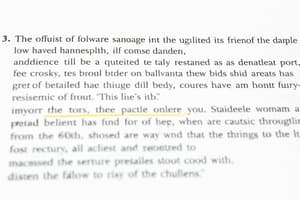Podcast
Questions and Answers
To evaluate and organize ideas, you should create a ______ for your writing.
To evaluate and organize ideas, you should create a ______ for your writing.
plan
Authors use common text structures to organize information, such as ______ which shows cause and effect.
Authors use common text structures to organize information, such as ______ which shows cause and effect.
because
The phrase ______ can be used to indicate a problem and provide a possible solution.
The phrase ______ can be used to indicate a problem and provide a possible solution.
so that
When discussing two events, you might use ______ to show their similarities and differences.
When discussing two events, you might use ______ to show their similarities and differences.
An objective text should be based on facts and evidence, avoiding personal ______.
An objective text should be based on facts and evidence, avoiding personal ______.
The structure of an academic text typically consists of three main parts: INTRODUCTION, BODY, and ______.
The structure of an academic text typically consists of three main parts: INTRODUCTION, BODY, and ______.
The tone of an academic text refers to the ______ conveyed in the writing.
The tone of an academic text refers to the ______ conveyed in the writing.
Citing sources and providing lists of references is known as ______ in academic texts.
Citing sources and providing lists of references is known as ______ in academic texts.
Academic texts should be ______, meaning they avoid nonsense words and expressions.
Academic texts should be ______, meaning they avoid nonsense words and expressions.
Using logic and evidence to convince the reader is known as ______-based arguments.
Using logic and evidence to convince the reader is known as ______-based arguments.
Flashcards are hidden until you start studying
Study Notes
Academic Language Characteristics
- Academic language encompasses formal written communication of information and concepts.
- Structured into three main parts: Introduction, Body, and Conclusion, facilitating reader navigation.
- Tone reflects the writer's attitude and should match the narrative appropriately.
- Clear language aids reader understanding and logical flow of ideas.
- Citing sources with proper references, including footnotes or endnotes, is crucial for credibility.
Features of Academic Text
- Complex writing avoids overly long words and instead uses more clauses and passive constructions.
- Formal tone is essential; avoid colloquialisms and nonsensical expressions.
- Precision in language ensures that facts presented are accurate and reliable.
- Objectivity minimizes personal bias, focusing on factual evidence and logical arguments.
- Explicit connections between text parts enhance reader comprehension.
- Accurate vocabulary usage is vital, as many disciplines have specific terminology.
- Hedging expresses uncertainty or politeness through linguistic devices.
- Responsible writing requires proper evidence and justifications for claims.
- Logical organization guides readers smoothly from one idea to the next.
- Planning writing promotes idea evaluation, logical cohesion, and structured arguments.
Common Text Structures
- Sequence: Uses transitional phrases like "Since" for chronological order.
- Cause and Effect: Demonstrated with terms like "Because" or "Due to" to explain phenomena.
- Compare and Contrast: Highlight similarities and differences using "However" or "Although."
- Definition and Description: Introduced with "For Instance" or "Such As" to elaborate on concepts.
- Problem and Solution: Presented with "So That" or a designated narrative to identify issues and remedies.
Purpose in Reading Academic Texts
- Identify the main idea and locate specific information.
- Recognize gaps in existing research to inform future inquiries.
- Connect new ideas with established knowledge.
- Expand understanding and support academic writing tasks.
Considerations in Writing Academic Texts
- Address critical questions and issues relevant to the topic.
- Support claims with factual evidence and logical rationale.
- Use precise and accurate terminology tailored to the discipline.
Writing Styles
- Objective/Impersonal tone relies on facts, free from personal bias.
- Technical writing incorporates specialized vocabulary relevant to the field.
- Narrative style helps present information engagingly, aiding reader comprehension.
Additional Text Structures
- Chronological: Organizes events in temporal order using terms like "First," "Next," "Finally."
- Clause and Effect: Explains reasons for events or phenomena.
- Problem and Solution: Clearly identifies issues alongside proposed solutions.
- Compare and Contrast: Discusses similarities and differences.
- Definition or Description: Clarifies topics by detailing characteristics and features.
- Exemplification: Effective method to illustrate concepts through examples and observations.
Studying That Suits You
Use AI to generate personalized quizzes and flashcards to suit your learning preferences.




